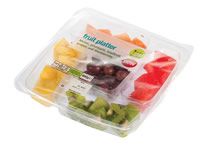Apart from the obvious saving of dampening water with its expensive and toxic VOC additives, waterless printing also delivers a sharper, more consistent dot than wet offset. Lower dot gain means finer screen rulings can be used and higher ink densities printed without the colour getting muddy. And, because there’s no need to consider the ink/water balance, waterless printing offers reduced make-ready time and waste – in fact, as much as 40% less.
Against that backdrop, let’s look first at waterless plates. Here a leading producer is Toray, whose stated aim is to deliver ‘green innovation products’.
Europe is an important growth area for Toray’s waterless printing plate business, especially following the introduction of KBA’s waterless Cortina web press a decade ago. With 19 KBA Cortina installations and a total of 85 print towers now in operation across Europe and the Middle East, sales of Toray’s waterless plates have soared, as no other manufacturer provides waterless plates for this segment.
Waterless printing offers many advantages, as explained to visitors a recent open day at Toray’s production site in the Czech Republic. Using T-E2A (Toray Eco-Efficiency Analysis), taking into account both Life Cycle Assessment (LCA) and Life Cycle Cost, Toray aims to protect the environment and ensure sustainable growth. At the open day, visitors learnt how waterless printing scores well in comparison to conventional printing on the eco-map.
In addition, the LCA analysis of newspaper printing on a KBA Cortina press compared to a conventional newspaper press shows a reduction of carbon dioxide emissions by several percentage points.
More than 50% of waterless plates produced at Toray’s Czech Republic site are tailored for KBA Cortina presses installed in Europe and Dubai. However, it’s not only the environmental benefits that convince newspaper printers to choose waterless printing. Those who only print newspapers face challenges as their markets continue to decline, but using Cortina presses combined with Toray plates allows them to produce semi-commercial jobs as well. They can make better use of their presses by printing newspapers at night and high-quality brochures, supplements or magazines on higher-grade paper stock during the day. In that way, they can expand their portfolios and their customer bases.
Waterless offset advantage of lables
Turning from newspaper and general commercial printing to label printing, a compelling example of going waterless is chronicled in a recent issue of Labels & Labeling magazine.
The article concerns a Brazilian converter called Degrafica Impressos, a pioneer in offset label printing. In 2011, this company installed Latin America’s first Codimag Viva 420 Aniflo press, to complement the region’s first Codimag Viva 340 installed in 2006. As a result, the company reports new business from food and liquor brands as well as boosting production of wine labels.
The company started life in the 1970s, printing envelopes and business cards on a single-colour Heidelberg letterpress machine; and in the late 1980s moved into offset with a single-colour Heidelberg Cylinder press, soon progressing to printing labels for the burgeoning wine market. Three more Heidelberg offset presses followed and wine labels became the company’s core.
In 2006, the printer saw an opportunity to print self-adhesive labels for the increasing number of higher-quality vineyards in the region, but wanted to stay with offset – hence the first move to waterless offset with Codimag.
The latest servo-driven Viva 420 Aniflo combines the advantages of intermittent-feed technology with the productivity of rotary printing. It has five offset and two flexo units, all with individual curing stations, as well as automatic register, hot stamping, inline inspection, UV varnishing and die-cutting capabilities.
With a 420mm web width and speeds up to 12 000 impressions/hour in semi-rotary mode, it brings improved productivity compared to the earlier 340mm-wide Codimag. The two presses now represent 50% of output and are dedicated to high-quality wine label jobs, with the second press bringing increased capacity and productivity by catering for both long- and short-run work.
Aniflo inking system
A key aspect of the machine is its Aniflo inking system – an anilox offset printing unit that eliminates production variables and allows full digital prepress settings.
With Codimag’s Aniflo system, ink volume is distributed by an anilox roller, providing perfect control over ink volume and density, without the need to adjust ink keys. As the system doesn’t use a relief plate and prints using a rubber blanket, dot gain is not related to the print pressure.
According to Ian Beswick of Beswick Machinery, local representative for both Codimag and Toray’s waterless plates, one critical thing about running waterless plates successfully is to use an offset press with accurate refrigerated temperature control of the inking fountain and, ideally, the plate cylinder.
‘It’s not practical to just start running waterless unless the press is equipped – again ideally – ex-factory with this control,’ Ian maintains. ‘One of Codimag’s advantages is that each inking unit and plate cylinder can be set individually to different temperatures.’
Clearly, many more column centimetres could be written about waterless printing, but space, as always, is at a premium.
What’s clear is this – by switching to waterless printing technology, printers can save time and money as well as water and trees. Less water consumption, less makeready waste, no toxic chemicals and higher quality – it all adds up to a smaller environmental footprint, a better competitive positioning of print media compared to resource-hungry electronic media, and cost savings for both printers and their customers.










